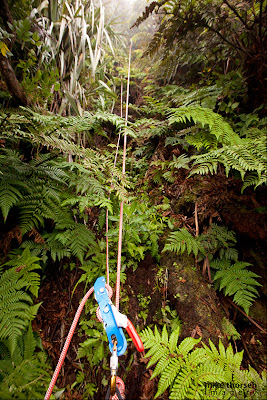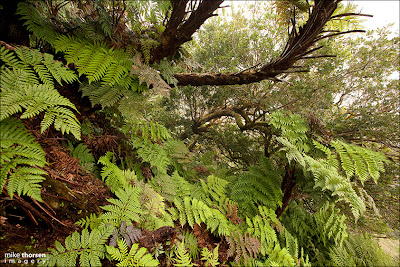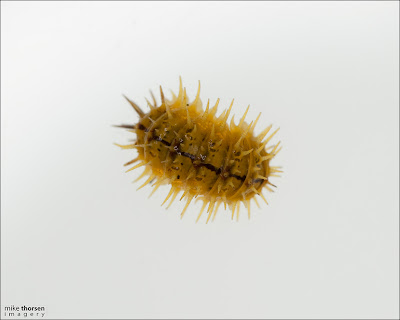Spiky yellow woodlouse (syw or spikys for short,
Pseudolaureola atlantica to those in academia) is a cute little critter only known from the highest peaks on St Helena. Well, it was known from there, but there seems to have been a dramatic decline and recent reports indicated it may only be known from one spot on High Peak - and even its continued existence there was uncertain. So we teamed up with Ed Thorpe and Annalea Beard, the two people who know most about spikys, to see if we could find them. Luckily they were still present in that one spot on High Peak, but short searches couldn't find them in similar habitats nearby. We started a rat-trapping and planting programme to protect this tiny population (of only about 50 individuals).
Recently Mike has been abseiling the very steep faces of High Peak. One of his discoveries was a large population of spikys in a fern grove under an exotic spoor (
Pittosporum viridiflorum) tree. While dangling off a rope a rough count of 23 individuals were made in the space of about 10 minutes - a marked contrast of the 6 individuals found by 4 people searching for an hour at the other site! Even better was the presence of very young spikys (no one really knew what they look like before). As Ed and Annalea have said, the preferred habitat for this species is the wet, shaded, black-scale fern (
Diplazium filamentosum) groves where it inhabits the underside of fronds. Unfortunately because most of the shading trees have disappeared off of St Helena's peaks this is not a common habitat. It is also known from tree ferns (
Dicksonia arborescens) and redwood (
Trochetiopsis erythroxylon) flowers. It's diet seems to consist of fern spores and possibly plant pollen.
Not much is known about spikys. We don't know how to tell males and females apart (presumably they can). Why are they spiky and yellow? Who knows! Maybe the spikes are a defence against the long fangs of the endemic spider
Tecution mellissi. And maybe spiders don't like yellow??
 |
| the abseil |
 |
| prime spiky real estate |
 |
| a family group? Juvenile spiky at rear |
 |
| like other woodlice/slater species, spikys roll into a ball when threatened |
 |
| ?female spiky underside? If you know, please let us know! |
 |
| ?male spiky underside? |























































